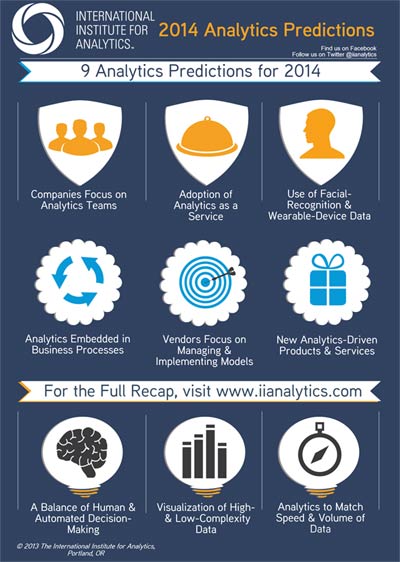Big Data Focus on Value, Not Hype, in 2014
While many organizations are still experimenting with Big Data analytics rather than undertaking full deployments, they want to achieve value from their initiatives sooner rather than later and are thus looking to areas such as automation and machine learning to help them maximize their investments.
This focus on value is the underlying theme of this year's round of predictions from the International Institute for Analytics (IIA), which each year identifies what its members see as the biggest trends in analytics.
“Companies realize that if they want to make use of Big Data, they will have to combine it with other data and feed the results into business processes the way they have done with traditional data,” said Bill Franks, an IIA member and the chief analytics officer at Teradata Corporation.
Analyzing the Industrial Internet
For a sign of how companies will be able to make this connection between Big Data analytics and process improvement, Robert Morison, co-author of “Analytics at Work: Smarter Decisions, Better Results,” pointed to GE's recent debut of a Big Data software platform called Predix, which its customers are using to boost efficiency and cut costs.
The idea is to collect data from the “industrial Internet,” analyze it to identify opportunities for improvement and send real-time information to GE's customers in power, aviation, rail and healthcare industries. GE predicts these kinds of applications could boost GDP by up to $15 trillion in the next 20 years through reduced labor costs, improvements in energy efficiency and enhanced productivity.
 In its recent announcement of new Predix-driven applications, GE cited two customers already using Predix: Brazil's Gol Airlines, which believes it will save $90 million over five years by analyzing and adapting its flight routes and fuel consumption, and St. Luke's Medical Center, which has shaved hospital bed turnaround times by 51 minutes.
In its recent announcement of new Predix-driven applications, GE cited two customers already using Predix: Brazil's Gol Airlines, which believes it will save $90 million over five years by analyzing and adapting its flight routes and fuel consumption, and St. Luke's Medical Center, which has shaved hospital bed turnaround times by 51 minutes.
GE's Predix incorporates several of the other trends mentioned by IIA members in their predictions, including growing adoption of machine learning/artificial intelligence, increased automation and accelerated usage of data visualization at both the high and low ends of the data complexity spectrum.
Rise of Machine Learning
Sanjeev Kumar, analytics product manager for Dell's Enterprise IT organization, mentioned the growing numbers of startups specializing in artificial intelligence receiving funding – or in the case of the UK's DeepMind, being acquired by Google.
Because of the sheer amount of data produced by sensors and other aspects of the industrial Internet, organizations “won't be to handle the volume of data” without machine learning, said Tom Davenport, co-founder and research director at IIA, a professor at Babson College and a research fellow at the MIT Center for Digital Business. There may be some initial bumps in the road, he said, as managers “determine how they will react to machine learning.”
Among IIA's other predictions:
Shift from Individual Analytics Professionals to Formation of Analytics Teams. As the discipline of analytics matures, analytics pros will become more embedded in business units, said Greta Roberts, the CEO of Talent Analytics, who believes at least some organizations will establish analytics centers of excellence as “potentially the next step to pull together disparate analytics professionals from business units to develop best practices.”
Teradata's Franklin noted an evolution in how companies view their Big Data pros since last year, when IIA focused on how companies would respond to a shortage of such pros. “Even a year-and-a half-ago companies were asking if they should be hiring, but in the last year they've begun asking what they should do with them,” he said. “They are not questioning the need for them but rather how to organize them.”
Companies Analyze Data They've Accumulated to Develop New Products/Services. Davenport mentioned several examples, including game designer Electronic Arts. In an interview with O'Reilly Media that took place about a year ago, former EA CTO Rajat Taneja (who has since left the company) described how EA “ingests, processes and efficiently stores the data across a wide variety of systems spanning structured and unstructured databases. … This data is then made available through a variety of analytic tools for automated actions, deeper analytics and reporting.”
Taneja went on to explain how “data and derived insight are made available to game developers and studios so they can gain deep insight into playing patterns and feature usage. This helps them tailor the game experiences and capabilities to enhance the enjoyment by our consumers.”
Adoption of Analytics-as-a-Service Will Accelerate. The growing business demand for analytics plus the continued scarcity of data talent means companies “can't possibly do all the analytics they'd like,” Morison said. In response, vendors are beginning to offer off-the-shelf software-as-a-service (SaaS) analytics applications, some geared toward specific verticals, as well as cloud infrastructures for analytics. Both of these can help companies get Big Data initiatives up and running quickly, he said, and also help them lower the learning curve.
“If you have a specific need, why not start with a service and see what you can learn,” he said.
Facial Recognition and Wearable Device Data Will Be Incorporated into Predictive Analytics. Franklin described how retailers can use cameras in their displays that can document when eyes look at advertisements and for how long, which would help the retailers optimize the type and placement of ads. Omer Sohail, who leads Deloitte's Analytics and Information Management practice for Financial Services in the U.S., said banks are beginning to use voice analytics to capture customers' tone of voice during calls in an effort to reduce customer churn.
Offering a workplace example, Roberts from Talent Analytics said a Boston startup has developed a wearable device that records the tone of employee conversations, analyzes the information and offers recommendations for collaborative opportunities. So, for example, a company might be able to determine that sales representatives that connect more with colleagues outside the sales function tend to get more sales.
Companies Will Focus on an Optimal Mix between Human and Machine Capability and Judgment. “Just because you can fully automate decisions, doesn't mean you should,” said Forester, noting that companies that remove humans from the analytics mix run the risk of losing touch with their own processes and seeing their decision-making skills atrophy.
“So if something unusual occurs, which is when you need humans, you cannot respond. Or if the system is unavailable, you cannot revert to your old procedures for getting stuff done,” he said.
Ann All is the editor of Enterprise Apps Today and eSecurity Planet. She has covered business and technology for more than a decade, writing about everything from business intelligence to virtualization.

Public relations, digital marketing, journalism, copywriting. I have done it all so I am able to communicate any information in a professional manner. Recent work includes creating compelling digital content, and applying SEO strategies to increase website performance. I am a skilled copy editor who can manage budgets and people.


